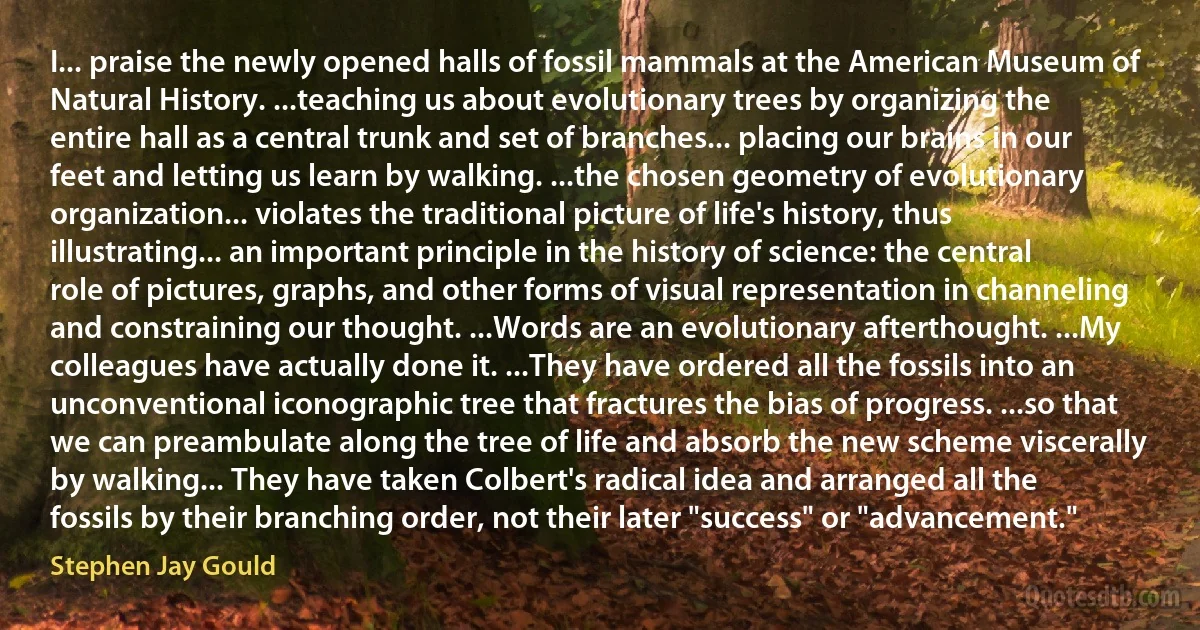
I... praise the newly opened halls of fossil mammals at the American Museum of Natural History. ...teaching us about evolutionary trees by organizing the entire hall as a central trunk and set of branches... placing our brains in our feet and letting us learn by walking. ...the chosen geometry of evolutionary organization... violates the traditional picture of life's history, thus illustrating... an important principle in the history of science: the central role of pictures, graphs, and other forms of visual representation in channeling and constraining our thought. ...Words are an evolutionary afterthought. ...My colleagues have actually done it. ...They have ordered all the fossils into an unconventional iconographic tree that fractures the bias of progress. ...so that we can preambulate along the tree of life and absorb the new scheme viscerally by walking... They have taken Colbert's radical idea and arranged all the fossils by their branching order, not their later "success" or "advancement."
Stephen Jay GouldRelated topics
advancement bias branching central channeling constraining done entire feet fossil geometry hall history idea later learn life museum natural order organization picture placing praise representation science set success take teaching thought thus traditional trunk visual walking words unconventional brains hallsRelated quotes
Even in Scandinavia, where social democratic institutions were far more culturally ingrained, membership of the EU-or even just participation in the World Trade Organization and other international agencies-appeared to constrain locally-initiated legislation. In short, social democracy seemed doomed by that same internationalization which its early theorists had so enthusiastically adumbrated as the future of capitalism.
From this perspective, social democracy-like liberalism-was a byproduct of the rise of the European nation-state: a political idea keyed to the social challenges of industrialization in developed societies. Not only was there no ‘socialism' in America, but social democracy as a working compromise between radical goals and liberal traditions lacked widespread support in any other continent. There was no shortage of enthusiasm for revolutionary socialism in much of the non-Western world, but the distinctively European compromise did not export well.

Tony Judt
David Galin, among other researchers, has pointed out that teachers have three main tasks: first, to train both hemispheres - not only the verbal, symbolic, logical left hemisphere, which has always been trained in the traditional education, but also the relational, holistic right hemisphere, which is largely neglected in today's schools; second, to train students to use the cognitive style suited to the tasks at hand; and third, to train students to be able to bring both styles - both hemispheres - to bear on a problem in an integrated manner.
When teachers can pair the complementary modes or fit one mode to the appropriate task, teaching and learning will become a much more precise process. Ultimately, the goal will be to develop both halves of the brain. Both modes are necessary for full human functioning and both are necessary for creative work of all kinds, whether writing or painting, developing a new theory in physics, or dealing with environmental problems.

Betty Edwards
Wars always were contests of similar competing powers, and the deepest structure of society remained the same, whether one won or the other. Contests of classes are fights for new principles, and the victory of the rising class transfers the society to a higher stage of development. Hence, compared with real war, the moral forces are of a superior kind: voluntary devoted collaboration instead of blind obedience, faith to ideals instead of fidelity to commanders, love for the class companions, for humanity, instead of patriotism. Their essential practice is not armed violence, not killing, but standing steadfast, enduring, persevering, persuading, organizing; their aim is not to smash the skulls but to open the brains. Sure, armed action will also play a role in the fight of the classes; the armed violence of the masters cannot be overcome in Tolstoian fashion like by patient suffering. It must be beaten down by force; but, by force animated by deep moral conviction.

Antonie Pannekoek
The approach that dominates organizational theory, teaching, and practice for most of the twentieth century looked at organizations from the top-down, starting with a view of the CEO as the "leader" who shapes the organization's strategy, structure, culture, and performance potential. The nature of work and the role of the workforce enter the analysis much later, after considerations of technology and organization design have been considered. However, if the key source of value in the twenty-first-century organization is to be derived from the workforce itself, an inversion of the dominant approach will be needed. The new perspective will start not at the top of the organization, but at but at the front lines, with people and the work itself - which is where value is created. Such an inversion will lead to a transformation in the management and organization of work workers, and knowledge. This transformation was signalled by McGregor, but we must go further.

Douglas McGregor
.. Our life is a pilgrim's progress. I once saw a very beautiful picture: it was a landscape at evening. In the distance on the right-hand side a row of hills appeared blue in the evening mist. Above those hills the splendour of the sunset, the grey clouds with their linings of silver and gold and purple. The landscape is a plain or heath covered with grass and its yellow leaves, for it was in autumn. Through the landscape a road leads to a high mountain far, far away, on the top of that mountain is a city wherein the setting sun casts a glory. On the road walks a pilgrim, staff in hand. He has been walking for a good long while already and he is very tired. And now he meets a woman, or figure in black, that makes one think of St. Paul's word: As being sorrowful yet always rejoicing. That Angel of God has been placed there to encourage the pilgrims and to answer their questions and the pilgrim asks her: Does the road go uphill then all the way? And the answer is: "Yes to the very end."

Vincent van Gogh
